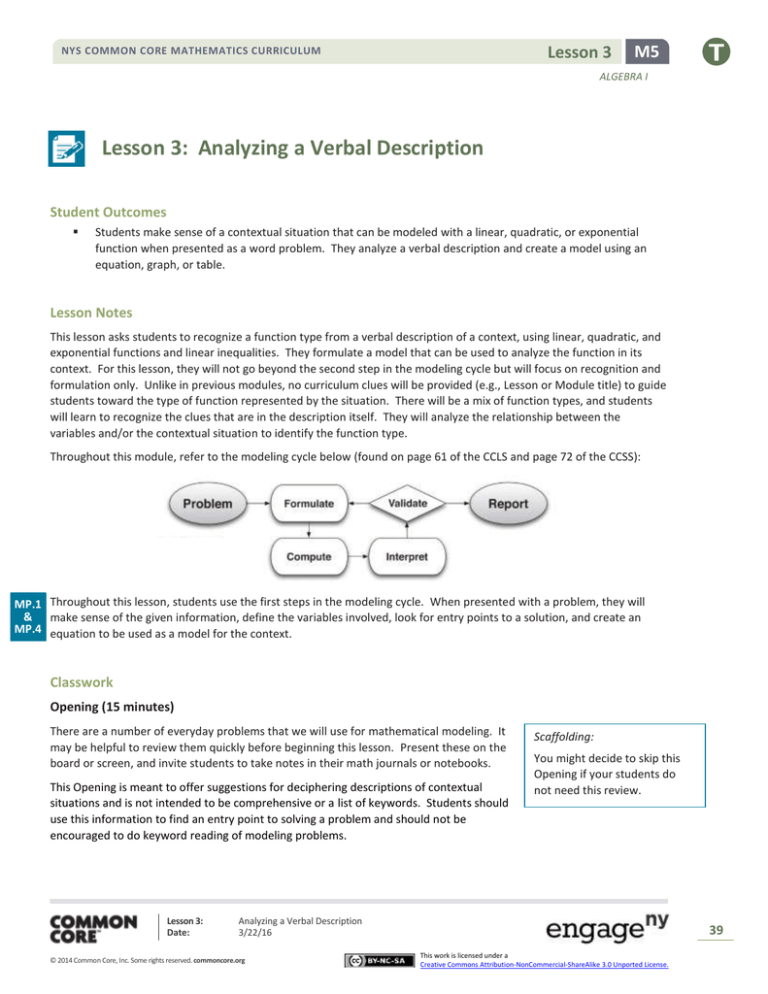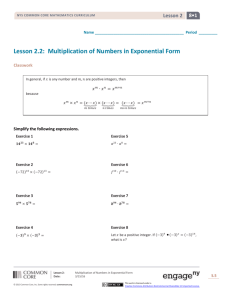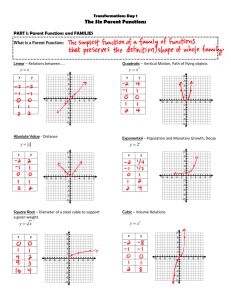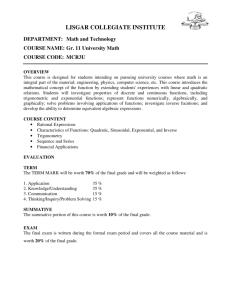
Lesson 3
NYS COMMON CORE MATHEMATICS CURRICULUM
M5
ALGEBRA I
Lesson 3: Analyzing a Verbal Description
Student Outcomes
Students make sense of a contextual situation that can be modeled with a linear, quadratic, or exponential
function when presented as a word problem. They analyze a verbal description and create a model using an
equation, graph, or table.
Lesson Notes
This lesson asks students to recognize a function type from a verbal description of a context, using linear, quadratic, and
exponential functions and linear inequalities. They formulate a model that can be used to analyze the function in its
context. For this lesson, they will not go beyond the second step in the modeling cycle but will focus on recognition and
formulation only. Unlike in previous modules, no curriculum clues will be provided (e.g., Lesson or Module title) to guide
students toward the type of function represented by the situation. There will be a mix of function types, and students
will learn to recognize the clues that are in the description itself. They will analyze the relationship between the
variables and/or the contextual situation to identify the function type.
Throughout this module, refer to the modeling cycle below (found on page 61 of the CCLS and page 72 of the CCSS):
MP.1 Throughout this lesson, students use the first steps in the modeling cycle. When presented with a problem, they will
& make sense of the given information, define the variables involved, look for entry points to a solution, and create an
MP.4 equation to be used as a model for the context.
Classwork
Opening (15 minutes)
There are a number of everyday problems that we will use for mathematical modeling. It
may be helpful to review them quickly before beginning this lesson. Present these on the
board or screen, and invite students to take notes in their math journals or notebooks.
This Opening is meant to offer suggestions for deciphering descriptions of contextual
situations and is not intended to be comprehensive or a list of keywords. Students should
use this information to find an entry point to solving a problem and should not be
encouraged to do keyword reading of modeling problems.
Lesson 3:
Date:
Scaffolding:
You might decide to skip this
Opening if your students do
not need this review.
Analyzing a Verbal Description
3/22/16
© 2014 Common Core, Inc. Some rights reserved. commoncore.org
39
This work is licensed under a
Creative Commons Attribution-NonCommercial-ShareAlike 3.0 Unported License.
Lesson 3
NYS COMMON CORE MATHEMATICS CURRICULUM
M5
ALGEBRA I
Rate problems—Linear
Rate problems relate two quantities, usually in different units. Rate problems commonly use some measure of distance
and time such as feet per second. These are called uniform rate word problems. Rate problems might also use
quantities that are not related to distance or time (e.g., pills per bottle, dollars per pound). Rate problems may also
relate the number of people to a space (e.g., students per class), the number of objects to a space (e.g., corn stalks per
row or rows of corn per field), dollars per mile (e.g., taxi fare), or dollars per person. The possibilities are limitless, and
remember that sometimes the uniform rate problem will include a flat fee plus a rate per unit, making the linear model a
bit more interesting.
The familiar formula (Rate)(Time) = Distance can be adjusted to accommodate any (or all) of the uniform
rate problem situations mentioned above. These use the equation of the form 𝑓(𝑥) = 𝑚𝑥 (or 𝑑 = 𝑟𝑡, etc.).
Sometimes the rate will be combined with a constant part (e.g., flat fee). For example, a taxi service charges $4
plus $2.50 per mile (times the mileage). These equations will use the form 𝑓(𝑥) = 𝑚𝑥 + 𝑏.
These problems might include inequalities with a maximum or minimum amount possible set by real-life
conditions. For example, in a rate problem there may be a minimum number of corn stalks needed in a stalksper-row problem or a maximum number of classrooms in a students-per-classroom problem.
Note: Be careful not to confuse a simple rate problem with one that involves the motion of a free falling object.
Objects in Motion and Area—Quadratic
Motion problems are related to free falling objects1 or projectiles under the influence of gravity. The functions used to
model these functions will always be quadratic and relate the distance from the initial position (i.e., the height from
which the object was dropped or projected into the air), measured in either feet or meters, to the time that has passed
(i.e., the number of seconds since the object was dropped or projected into the air).
In area problems with dimensions that are variable and linear, expressions representing areas will be quadratic.
When distances are measured in feet, we use ℎ(𝑡) = −16𝑡 2 + 𝑣0 𝑡 + ℎ0 , where ℎ = height of the object in feet,
𝑡 = time in seconds, 𝑣0 = initial velocity, and ℎ0 = initial position (starting height).
When distances are measured in meters, we use ℎ(𝑡) = −4.9𝑡 2 + 𝑣0 𝑡 + ℎ0 , with all the same variables as
above.
When linear measurements have first-degree variables and are used to find area, the result will likely be a
quadratic model.
For rectangular area, 𝐴 = (𝑙)(𝑤); for triangles, 𝐴 = (𝑏)(ℎ); for trapezoids, 𝐴 = (𝑏1 + 𝑏2 )(ℎ). All of these,
1
2
1
2
and many others, can lead to a quadratic function that models the area of the 2-dimensional figure.
Growth problems—Exponential
Exponential problems could involve growth or decay of money (e.g., interest earned or paid), percent growth or decay
(e.g., inflation or depreciation), radioactive material (e.g., half-life problems), population (e.g., bacteria, humans, or
rabbits), etc.
The general form for any problem related to exponential growth is 𝑓(𝑥) = 𝑎𝑏 𝑥 , where 𝑎 and 𝑏 are constant
values. You can use this form for just about every exponential growth problem, but there are some special
cases for which we have special forms of this same function (see the following).
1
Free falling objects: Objects that are projected, launched, thrown, or dropped, without the aid of a motor (or other device) that
provides additional force beyond the initial projection of the object. The object might be shot from a cannon or dropped from a cliff
but will have no rotors, motor, wing, or other device to keep it aloft or defy gravity.
Lesson 3:
Date:
Analyzing a Verbal Description
3/22/16
© 2014 Common Core, Inc. Some rights reserved. commoncore.org
40
This work is licensed under a
Creative Commons Attribution-NonCommercial-ShareAlike 3.0 Unported License.
Lesson 3
NYS COMMON CORE MATHEMATICS CURRICULUM
M5
ALGEBRA I
Except in problems of compounded interest, encourage students to use the general exponential form for most problems
related to growth, as it is usually the most efficient.
Depending on how the interest is compounded, we would use different forms of the growth function. Until you
get a little further in your math studies, we will use the annual compound interest formula:
𝑟 𝑛𝑡
𝑛
𝑃(𝑡) = 𝑃0 (1 + ) , where 𝑃 represents the current or future value of the money, 𝑃0 is the principal amount
(the initial investment), 𝑟 is the annual interest rate, 𝑛 represents the number of times per year the interest is
compounded, and 𝑡 is the number of years the interest is earned or paid.
Population growth is generally modeled with the general exponential function form. Sometimes it is helpful to
know a few commonly used variables: 𝑃(𝑛) = 𝑃0 (1 + 𝑟)𝑛 , where 𝑃 represents the future population, 𝑃0 is the
initial population, 𝑟 is the growth rate, and 𝑛 is the number of time periods of growth.
Sometimes in growth problems, you need to determine a percentage rate of growth over an interval of time. If
that happens, use this strategy: Find the total growth for the interval, (𝑃 − 𝑃0 ) and divide by 𝑃0 (the starting
population or value). This gives you a ratio representing the new growth to the starting population or value.
This result will be in decimal form and can be used that way or changed to a percentage. So, to recap: A
percentage rate of growth for an interval can be determined by the expression:
100(𝑃 − 𝑃0 )
𝑃0
.
Do you see that all these exponential formulas are different forms of the general exponential equation in the
first bullet? 𝑓(𝑥) = 𝑎𝑏 𝑥 ?
To highlight MP.7, ask students to identify and interpret 𝑎 and 𝑏 in the various examples above.
Have students work the three examples below with a partner or small groups. Give them about 2 minutes to work on
the function, and then pause to have the group discuss the suggested questions together. Try to keep this to about 5
minutes per example.
Example 1 (5 minutes)
Have students read the problem. Then, use the questions that follow to guide a
discussion. Offering a variety of tools for students to use while engaging with these
examples will promote MP.5 and allow multiple entry points for model development.
Consider offering access to a graphing calculator or graphing computer software, graph
paper, and a spreadsheet program.
Example 1
Gregory plans to purchase a video game player. He has $𝟓𝟎𝟎 in his savings account and plans to
save $𝟐𝟎 per week from his allowance until he has enough money to buy the player. He needs to
figure out how long it will take. What type of function should he use to model this problem?
Justify your answer mathematically.
Gregory decides that the exponential function can best represent the situation.
Do you agree or disagree? Why? Support your answer mathematically.
Scaffolding:
Have struggling students
keep notes in their math
journals or notebooks
where all contextual
scenarios (and the
corresponding functions
used) are recorded as the
class works through the
examples.
Having this notebook
readily available will
benefit all students.
I disagree because Gregory’s money increases at a constant rate of $20 a week with a starting balance
of $500. The graph of the amount of money that Gregory saves over a period of time will be a linear
model.
Lesson 3:
Date:
Analyzing a Verbal Description
3/22/16
© 2014 Common Core, Inc. Some rights reserved. commoncore.org
41
This work is licensed under a
Creative Commons Attribution-NonCommercial-ShareAlike 3.0 Unported License.
Lesson 3
NYS COMMON CORE MATHEMATICS CURRICULUM
M5
ALGEBRA I
What are the variables and quantities of this problem?
The rate is $20 per week, 𝑤 is the number of weeks, and the initial value is $500.
What function represents the amount of Gregory’s money over a period of time (in weeks)?
The model is 𝑓(𝑤) = 20𝑤 + 500. If the function is graphed, the slope of the line will be 20 to reflect
the constant rate of $20/week, and the 𝑦-intercept will be $500, the initial amount.
Example 2 (5 minutes)
Example 2
One of the highlights in a car show event is a car driving up a ramp and flying over approximately five cars placed end-toend. The ramp is 𝟖 𝐟𝐭. at its highest point, and there is an upward speed of 𝟖𝟖 𝐟𝐭/𝐬𝐞𝐜 before it leaves the top of the
ramp. What type of function can best model the height, 𝒉, in feet, of the car 𝒕 seconds after leaving the end of the ramp?
Justify your answer mathematically.
What type of function can best model the height, ℎ, in feet, of the car 𝑡 seconds after leaving the end of the
ramp? What were your clues? Justify your answer mathematically.
Quadratic function. This is an object in motion problem. The car would leave the ramp in an upward
and forward motion and then, after travelling higher for a short time, would begin the fall due to the
force of gravity.
What form would the equation take?
Since the distance is measured in feet and the time in seconds, we would use
ℎ(𝑡) = −16𝑡 2 + 𝑣0 𝑡 + ℎ0 , and the equation would be ℎ(𝑡) = −16𝑡 2 + 88𝑡 + 8
Example 3 (5 minutes)
Example 3
Margie got $𝟏, 𝟎𝟎𝟎 from her grandmother to start her college fund. She is opening a new savings account and finds out
that her bank offers a 𝟐% annual interest rate, compounded monthly. What type of function would best represent the
amount of money in Margie’s account? Justify your answer mathematically.
What type of function would best represent the amount of money in Margie’s account? Justify your answer
mathematically.
Exponential Function. The amount of deposited money grows over time at a constant rate, and the
pattern can be best described by an exponential function, 𝑓(𝑥) = 𝑎𝑏 𝑥 , where 𝑎 represents the initial
𝑟
𝑛
investment, and 𝑏 is the expression (1 + ) as defined in the compounded interest formula:
𝑟
𝑛
𝑛𝑡
𝑃(𝑡) = 𝑃0 (1 + ) .
What function represents the amount of money deposited in the bank compounded monthly at the rate of 2%,
if the initial amount of deposit was $1,000?
𝐴(𝑛) = 1000 (1 +
Lesson 3:
Date:
0.02 12𝑡
)
12
Analyzing a Verbal Description
3/22/16
© 2014 Common Core, Inc. Some rights reserved. commoncore.org
42
This work is licensed under a
Creative Commons Attribution-NonCommercial-ShareAlike 3.0 Unported License.
Lesson 3
NYS COMMON CORE MATHEMATICS CURRICULUM
M5
ALGEBRA I
Note that we do not know how long Margie plans to leave the money in her account, so we do not know what
the value of 𝑡 is yet.
Remind students that percentages, in most cases, must be changed to decimals when used in exponential expressions.
Exercises (12 minutes)
Have students work with a partner or small group to determine the function model for the situation described. Circulate
around the room to make sure students understand the exercises. If time is short, some of these might be used for
additional homework.
Exercises
1.
City workers recorded the number of squirrels in a park over a period of time. At the first count, there were 𝟏𝟓
pairs of male and female squirrels (𝟑𝟎 squirrels total). After 𝟔 months, the city workers recorded a total of 𝟔𝟎
squirrels, and after a year, there were 𝟏𝟐𝟎.
a.
What type of function can best model the population of squirrels recorded over a period of time, assuming
the same growth rate and that no squirrel dies?
Exponential Function.
b.
Write a function that represents the population of squirrels recorded over 𝒙 number of years. Explain how
you determined your function.
Students may use the general exponential function 𝒇(𝒙) = 𝒂𝒃𝒙, by figuring out that this is a doubling
exponential problem (in this case, the number of squirrels doubles every 𝟔 months). So, the function would be
𝒇(𝒙) = 𝟑𝟎(𝟐)𝟐𝒙 because the squirrel population would double twice each year.
2.
A rectangular photograph measuring 𝟖 𝐢𝐧. by 𝟏𝟎 𝐢𝐧. is surrounded by a frame with a uniform width, 𝒙.
a.
What type of function can best represent the area of the picture and the frame in terms of 𝒙 (the unknown
frame’s width)? Explain mathematically how you know.
Quadratic Function. This is an area problem where the product of two linear measurements will result in a
quadratic.
b.
Write an equation in standard form representing the area of the picture and the frame. Explain how you
arrive at your equation.
The dimensions of the picture are 𝟖 𝐢𝐧. by 𝟏𝟎 𝐢𝐧. Taking into consideration the width of the frame, we have
to add 𝟐𝒙 to both the width and the length of the picture. Doing so results in (𝟖 + 𝟐𝒙) and (𝟏𝟎 + 𝟐𝒙). So,
the area of the picture and the frame is 𝑨(𝒙) = (𝟖 + 𝟐𝒙)(𝟏𝟎 + 𝟐𝒙) or 𝑨(𝒙) = 𝟒𝒙𝟐 + 𝟑𝟔𝒙 + 𝟖𝟎.
3.
A ball is tossed up in the air at an initial rate of 𝟓𝟎 𝐟𝐭/𝐬𝐞𝐜 from 𝟓 𝐟𝐭. off the ground.
a.
What type of function models the height (𝒉, in feet) of the ball after 𝒕 seconds?
Quadratic Function
b.
Explain what is happening to the height of the ball as it travels over a period of time (in 𝒕 seconds).
The initial height of the ball is 𝟓 𝐟𝐭., and it travels upward with an initial velocity of 𝟓𝟎 𝐟𝐭/𝐬𝐞𝐜. As time
increases, the ball continues to travel upward, with the force of gravity slowing it down, until it reaches the
maximum height and falls back to the ground.
Lesson 3:
Date:
Analyzing a Verbal Description
3/22/16
© 2014 Common Core, Inc. Some rights reserved. commoncore.org
43
This work is licensed under a
Creative Commons Attribution-NonCommercial-ShareAlike 3.0 Unported License.
Lesson 3
NYS COMMON CORE MATHEMATICS CURRICULUM
M5
ALGEBRA I
What function models the height, 𝒉 (in feet), of the ball over a period of time (in 𝒕 seconds)?
c.
𝒉(𝒙) = −𝟏𝟔𝒕𝟐 + 𝟓𝟎𝒕 + 𝟓
4.
A population of insects is known to triple in size every month. At the beginning of a scientific research project, there
were 𝟐𝟎𝟎 insects.
What type of function models the population of the insects after 𝒕 years?
a.
Exponential Function
Write a function that models the population growth of the insects after 𝒕 years.
b.
Using the general form for exponential growth (𝒃 = 𝟑), we have the initial population of 𝟐𝟎𝟎 and 𝟏𝟐𝒕 is the
number of growth cycles over 𝒕 years. The function would be 𝒇(𝒕) = 𝟐𝟎𝟎(𝟑)𝟏𝟐𝒕.
𝑷 = 𝑷𝟎 (𝟏 + 𝒓)𝒏𝒕
𝑷(𝒕) = 𝟐𝟎𝟎(𝟏 + 𝟐)𝟏𝟐𝒕, where 𝒓 = growth rate at 𝟐𝟎𝟎% and 𝒏 = 𝟏𝟐.
So, 𝑷(𝒕) = 𝟐𝟎𝟎(𝟑)𝟏𝟐𝒕.
Closing (1 minute)
How would you know which function to use to model a word problem?
If the word problem talks about repeatedly adding or subtracting a constant value, then it is linear. If
the problem involves motion of objects subject to non-zero, constant acceleration (e.g., gravity) over
time, or represents an area, then it is quadratic. If the problem is about conventional population
growth or compounded interest with a constant growth rate, it is exponential.
Lesson Summary
The following methods can be used to recognize a function type from a word problem:
1.
If a problem requires repeated addition or subtraction of a constant value, then it is represented by a linear
function.
2.
If a problem involves free-falling motion of an object or an area, then it is represented by a quadratic function.
3.
If a problem is about population growth or compound interest, then it is represented by an exponential
function.
Exit Ticket (2 minutes)
Lesson 3:
Date:
Analyzing a Verbal Description
3/22/16
© 2014 Common Core, Inc. Some rights reserved. commoncore.org
44
This work is licensed under a
Creative Commons Attribution-NonCommercial-ShareAlike 3.0 Unported License.
Lesson 3
NYS COMMON CORE MATHEMATICS CURRICULUM
M5
ALGEBRA I
Name
Date
Lesson 3: Analyzing a Verbal Description
Exit Ticket
Create a model to compare these two texting plans:
a.
Plan A costs $15 a month, including 200 free texts. After 200, they cost $0.15 each.
b.
Plan B costs $20 a month, including 250 free texts. After 250, they cost $0.10 each.
Lesson 3:
Date:
Analyzing a Verbal Description
3/22/16
© 2014 Common Core, Inc. Some rights reserved. commoncore.org
45
This work is licensed under a
Creative Commons Attribution-NonCommercial-ShareAlike 3.0 Unported License.
Lesson 3
NYS COMMON CORE MATHEMATICS CURRICULUM
M5
ALGEBRA I
Exit Ticket Sample Solutions
Create a model to compare these two texting plans:
a.
Plan A costs $𝟏𝟓 a month, including 𝟐𝟎𝟎 free texts. After 𝟐𝟎𝟎, they cost $𝟎. 𝟏𝟓 each.
b.
Plan B costs $𝟐𝟎 a month, including 𝟐𝟓𝟎 free texts. After 𝟐𝟓𝟎, they cost $𝟎. 𝟏𝟎 each.
𝟏𝟓,
𝟏𝟓 + 𝟎. 𝟏𝟓(𝒕 − 𝟐𝟎𝟎),
𝐢𝐟 𝒕 ≤ 𝟐𝟎𝟎
where 𝒕 = number of texts per month
𝐢𝐟 𝒕 > 𝟐𝟎𝟎
𝟐𝟎,
𝟐𝟎 + 𝟎. 𝟏𝟎(𝒕 − 𝟐𝟓𝟎),
𝐢𝐟 𝒕 ≤ 𝟐𝟓𝟎
where 𝒕 = number of texts per month
𝐢𝐟 𝒕 > 𝟐𝟓𝟎
Monthly cost of Plan A:
𝑨(𝒕) = {
Monthly cost of Plan B:
𝑩(𝒕) = {
Problem Set Sample Solutions
If time allows, the following Problem Set can be used for additional practice. Otherwise, give this Problem Set as
homework. Some of these questions will go one step further (i.e., they may ask an interpretive question), but they will
not complete the modeling cycle.
1.
The costs to purchase school spirit posters are as follows: two posters for $𝟓, four posters for $𝟗, six posters for
$𝟏𝟑, eight posters for $𝟏𝟕, and so on.
a.
What type of function would best represent the cost of the total number of posters purchased?
Linear Function
b.
What function represents the cost of the total number of posters purchased? How did you know? Justify
your reasoning.
Let 𝒙 = number of school spirit posters. The four ordered pairs indicate a constant rate of change, (𝒎 = 𝟐),
so the equation will be 𝒚 = 𝟐𝒙 + 𝒃. To find 𝒃, we need to substitute any ordered pair, say (𝟐, 𝟓):
𝟓 = 𝟐(𝟐) + 𝒃, so 𝒃 = 𝟏. The final equation for the function is 𝒇(𝒙) = 𝟐𝒙 + 𝟏.
c.
If you have $𝟒𝟎 to spend, write an inequality to find the maximum number of posters you could buy.
𝟐𝒙 + 𝟏 ≤ 𝟒𝟎
2.
NYC Sports Gym had 𝟒𝟐𝟓 members in 2011. Based on statistics, the total number of memberships increases by 𝟐%
annually.
a.
What type of function models the total number of memberships in this situation?
Exponential Function
b.
If the trend continues, what function represents the total number of memberships in 𝒏 years? How did you
know? Justify your reasoning.
𝒇(𝒏) = 𝟒𝟐𝟓(𝟏 + 𝟎. 𝟎𝟐)𝒏
The initial number of members is 𝟒𝟐𝟓. The yearly growth rate of 𝟐% means I have to multiply by 𝟏. 𝟎𝟐 for
each year. So, 𝟏. 𝟎𝟐 will be the common ratio for this exponential function.
Lesson 3:
Date:
Analyzing a Verbal Description
3/22/16
© 2014 Common Core, Inc. Some rights reserved. commoncore.org
46
This work is licensed under a
Creative Commons Attribution-NonCommercial-ShareAlike 3.0 Unported License.
Lesson 3
NYS COMMON CORE MATHEMATICS CURRICULUM
M5
ALGEBRA I
3.
Derek hits a baseball thrown by the pitcher with an initial upward speed of 𝟔𝟎 𝐟𝐭/𝐬𝐞𝐜 from a height of 𝟑 𝐟𝐭.
a.
What type of function models the height of the baseball versus time since it was hit?
Quadratic Function
b.
What is the function that models the height, 𝒉 (in feet), the baseball travels over a period of time in 𝒕
seconds? How did you know? Justify your reasoning.
Since the initial velocity is 𝟔𝟎 𝐟𝐭/𝐬𝐞𝐜 and the initial height is 𝟑 𝐟𝐭., then I use the basic formula:
𝒉(𝒕) = −𝟏𝟔𝒕𝟐 + 𝑽𝟎 𝒕 + 𝒉𝟎 to find the function that describes the situation. The function equation is
𝒉(𝒕) = −𝟏𝟔𝒕𝟐 + 𝟔𝟎𝒕 + 𝟑.
Lesson 3:
Date:
Analyzing a Verbal Description
3/22/16
© 2014 Common Core, Inc. Some rights reserved. commoncore.org
47
This work is licensed under a
Creative Commons Attribution-NonCommercial-ShareAlike 3.0 Unported License.







